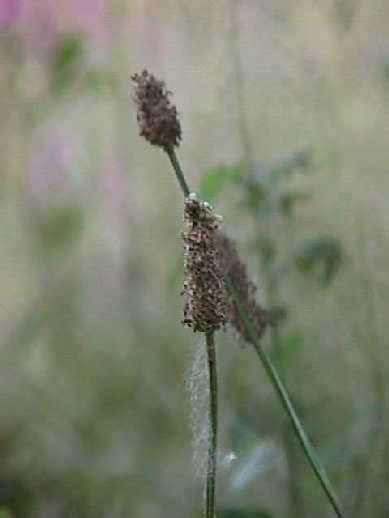
General Species Description
- Rib plantain is an exotic perennial species with basal rosettes of nonsucculent leaves. This species has fibrous root, and growing to a height of 20-60cm. It is hairless or tan-woolly at the base, and has straggly-hairy, several flowering stems that are groove-angled. The flowering stem is considerably longer than leaves.
Leaves
- The basal leaves are lance-shaped to narrowly oblong, with several strongly grooved parallel veins, and can be beige-wooly at the base, and hairless to scattered with hairs above.
Inflorescence/Flowers
- The flowers of Rib plantain are borne in a compact, core-shaped spike on top of the stem. This species flowers with petals 2-2.5mm long; sepals hairy toward tip; borne in dense spike2-8cm long. It blooms between April and August.
Fruits
- Rib plantain has oblong-egg-shaped capsules, and it split all the way around below the middle of the spike; seeds 1-2mm, shining black.
Habitat
- Rib plantain is common in weedy areas of backyards, along roads, and in other disturbed places. Infrequent in habitats on edges of freshwater emergent wetlands in association with Red clover (Trifolium pratense), White clover (Trifolium repens), non-native grasses, and other weedy species.
Range
- Rib plantain occurs in all countries in our area. It is a common weed most likely introduced from Europe.
Similar Species
- Seaside plantain (Plantago maritima) is a salt marsh inhabitant which has thin, straight leaves that are fleshy and not obviously veined.
Ecological Value
- This information was not found.
Human Value
- " The young plants of these species have a citrus flavor and may be used as a potherb or in salads. Older plants are unpalatably fibrous. Crushed leaves have a cauterizing and "drawing" agent used for removal of toxins in boils, splinters, etc. the leaves have also been used as a cure for dropsy, and chewed for toothache and gumdisease. The seeds may be eaten parched or ground into meal. They have reportedly been used as a laxative" (Cooke 1997).
References
- Cooke, S. S., ed. 1997. A Field Guide to the Common Wetland Plants of Western Washington & Northwest Oregon. Seattle Audubon Society and Washington Native Plant Society. Seattle Audubon Society, Seattle WA, 155pp. Pojar, J. and A. MacKinnon. 1994. Plants of the Pacific Northwest Coast. Lone Star Publishing, Richmond WA, 329pp.
This page was created by: Masamichi Ogasawara, August 1999
Return to Northwest Oregon Wetland Plants Project